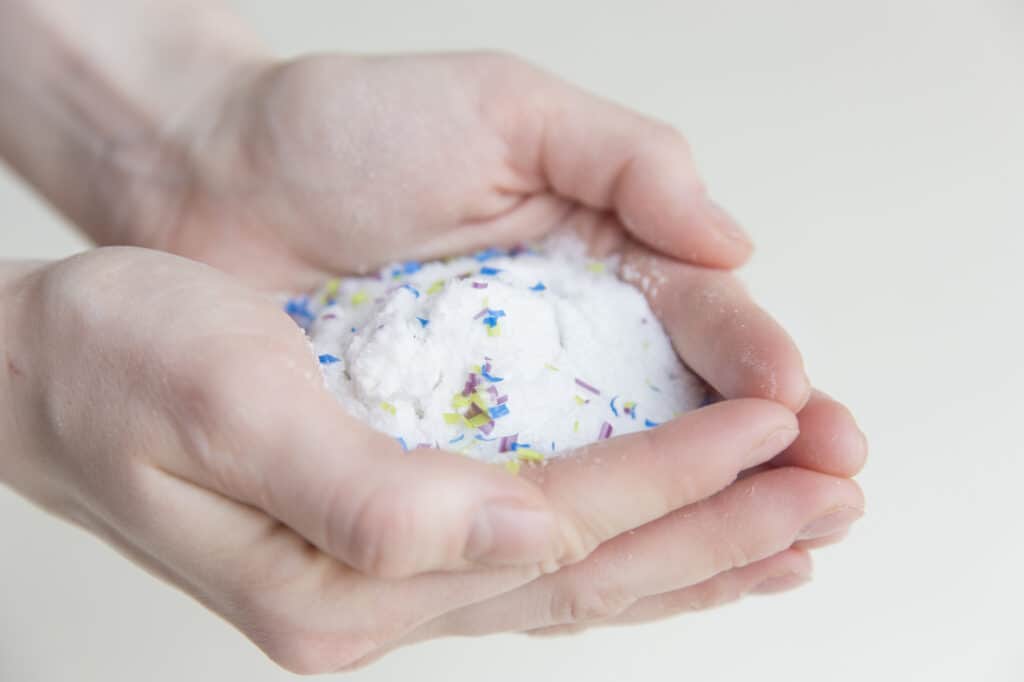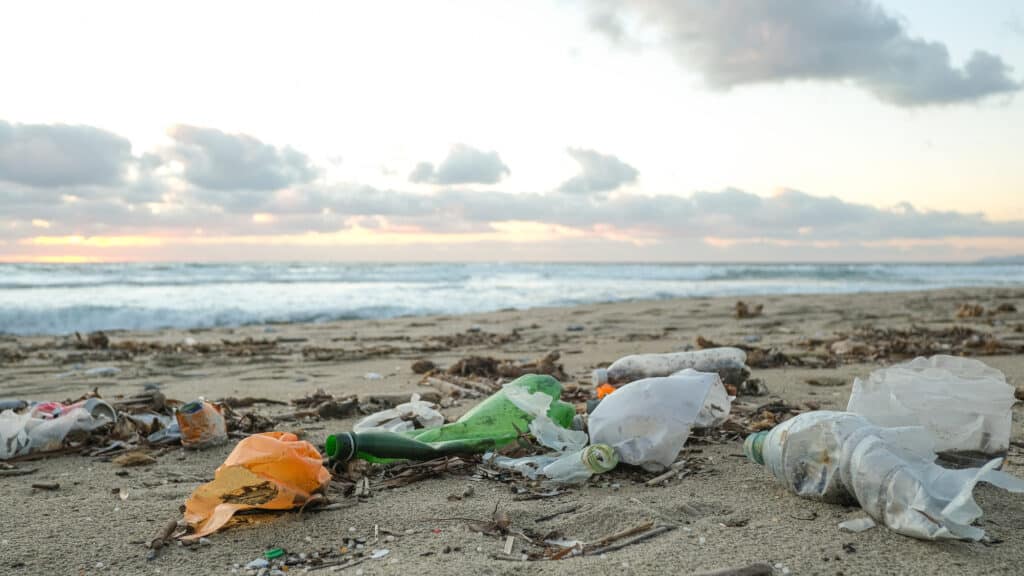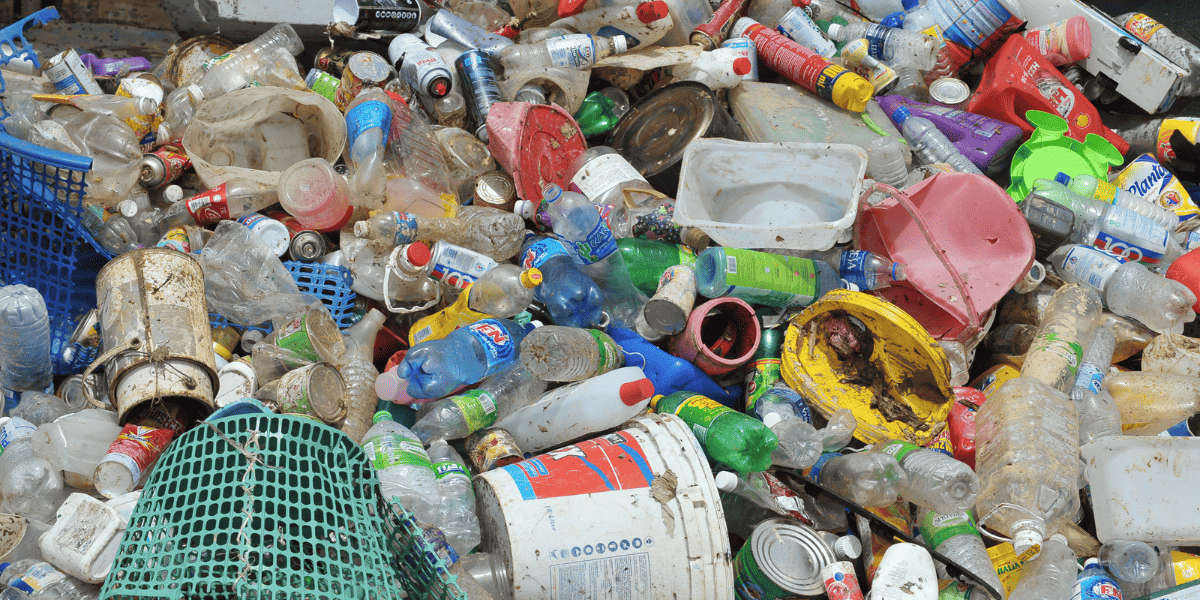EDITOR’S SUMMARY: When has a society gone too far—opting for convenience first, driving so-called “advancements,” and allowing corporate greed to override the health of its people and environment? With innumerable particles of toxic plastics lining the streets, toppling over in our landfills, submerged in the oceans, and breaking down in our bodies … You could say collectively, we have bypassed the wellness of our ecosystems, as we attempt to backtrack to safety.
**This article was last updated on 04-19-25 (see below).
*This article was updated on 08-04-24 (see below).
Written by Rick Rydell
Edited by Nicki Steinberger, Ph.D.
What’s in your human body? Even children can list off several parts. There’s the scientific and tangible, of course—bones, tissues and organs—and the philosophical and psychological—memories, dreams, and personality traits. Scads of recent studies, however, show a more modern addition: microplastics.
Microplastics are exactly what their name sounds like: really, really tiny pieces of plastic. Technically, this occurs when individual pieces of plastic take up less than five millimeters on the ruler, which may be visible to the naked eye. But microplastics can also be so miniscule (with an upper-end size of either 1000 or 100 nanometers; a sheet of paper is about 100,000 nanometers thick), that they are more like powder, of which scientists call nanoplastics.
Researchers are discovering that microplastics in our environment are simply everywhere, including human lungs and other organs, the gastrointestinal tract, brains, testis and semen, blood, and unfortunately in the placentas of unborn children. A 2019 study out of Newcastle University in Australia, estimated that humans could be ingesting as much as five grams of microplastics every week, which is about the weight of a credit card.
Clearly, this is not an issue your great-grandparents faced, but face it you must. This includes answering these questions:
- How does microplastic consumption affect you?
- Are you powerless in your ability to filter out the miniature bits?
- Is there anything you can do to lessen your consumption, that would make a difference for yourself and future generations?
Plastic Tsunami
Since you are not purposefully sprinkling chunks of plastic on your morning granola, it’s worth addressing the obvious question: How do they get into your body? Consider your day, for example; how many plastic items does your mouth come into contact with?
Picture your morning routine, including hygiene (retainers are plastic; toothpaste and mouthwash come in plastic containers; most toothbrushes are plastic, including bristles). You head to the kitchen and drink coffee and creamer that came from plastic jugs or bags. You pour milk into your cereal from a plastic carton, and chew cereal or toast stored in plastic liners. As you head out the door, you pop in your favorite gum that is stored in a plastic box. And that’s just by 8:00 a.m.!
That doesn’t even count the nanoplastics you breathe in simply by existing. A study out of France and Turkey showed that air inhaled by humans contains an average of 9.8 microplastics particles per m³.
Plastic, by design, was meant for durability. It lasts a long time, and is easily portable but can break, as anyone who has eaten a chicken Caesar salad with a plastic fork knows. And it will break, break, and break some more. Eventually, the original plastic item, through factors like use or weather, gets broken down to such a small degree that it becomes invisible and airborne. So you either inhale, drink, or eat it, all inadvertently.
Speaking of drinking: You may recall a time when you drank from a disposable water bottle that had been sitting in the sun. The water probably tasted a little different than normal, right? There’s a good chance that was plastic your tongue was detecting, because bottled water has about twice the levels of microplastic as tap water.
Good luck finding a disposable water bottle brand that’s clean, even if it’s never been lingering outside, or left in a car to bake. A 2018 study out of Penn State found bits of plastic in 93% of sampled water bottles. Similarly, public water fountains are not much better (though they clearly use less plastic); a study out of Mexico from the journal, Environmental Pollution, found microplastics in every sample analyzed from 42 public water fountains in Mexico City.
Alarmingly, drinking a healing herbal tea can also double up as a microplastics highway into your body. One study out of the journal, Environmental Science & Technology, found that plastic teabags—the ones you steep in boiling water—release billions of tiny bits of microplastics into your beverage. In addition, paper tea bags may be sealed with plastic glue.
Even babies are not immune to this plastic fiasco. A study from Nature Foods found that normal preparation of plastic baby bottles, including adding hot water, then vigorously shaking to mix the water with formula, releases a huge number of microplastics, which are then slurped up by your innocent child. Infants around the globe may be consuming more than 1.5 million particles of microplastics per day on average, the authors concluded.

Microplastics, Macro-Mysterious
It’s not like you’re choking daily on plastic chunks, or walking around with colorful plastic bits decorating your abdomen. However, based on what’s known so far, you can pretty much assume you have microplastics in your body. And in case you’re questioning if that is necessarily a bad thing, or wondering if they can actually hurt you, because they’re so tiny that you do not feel them, it may call for patience, as scientific studies seek to provide further answers.
In 2022, the World Health Organization (WHO) said the following in a report on microplastics:
“Although the limited data provide little evidence that nano- and microplastic particles have adverse effects in humans, there is increasing public awareness and an overwhelming consensus among all stakeholders that plastics do not belong in the environment, and measures should be taken to mitigate exposure.”
From “Impact of Microplastics and Nanoplastics on Human Health,” published in 2021 in Nanomaterials:
“Based on the findings of recent studies, further research is needed to investigate the potential mechanisms of micro- and nanoplastics toxicity in humans. Moreover, it is important to understand whether microplastics and nanoplastics can be further degraded after ingestion under the acidic conditions in the gut or inside the lysosomes of the cells. Hence, the long-term fate of the ingested microplastics and nanoplastics in human body warrant further investigation.”
The lack of conclusive research also means you cannot look to specific health symptoms and say, this is clearly caused by my microplastics consumption. What is known from various scientific studies is this: Exposure to microplastics may increase your risk for obesity by affecting metabolism, and promoting the growth of fat cells. Lab mice exposed to microplastics in their bodies had worse memory and learning skills. And ingested microplastics can also deform cell membranes and disturb their functioning.
Experimental physicist, Jean-Baptiste Fleury, who is conducting research at the University of Saarland, had this to say:
“A priori, microplastics are not fatal immediately after ingestion into living organisms. However, it is increasingly recognized that microplastics can oxidize or stress cells through biological processes. The possibility of they may also stress a cell membrane through purely physical processes, however, is completely ignored by the vast majority of studies.”
To that end, a 2023 report from the California State Policy Evidence Consortium (CalSPEC), linked human consumption of microplastics to digestive, reproductive, and respiratory harm. There is apparently enough existing evidence to be concerned about the environmental and human health consequences of microplastics consumption, but not enough to come to any firm conclusions on symptoms or outcomes.
However, it’s not a far leap to at least partially deduce that such a large amount of non-natural substances in your bloodstream (and everywhere else) simply cannot be good. Thus far, scientists have identified more than 10,000 unique chemicals used to make plastics. Over 2,400 of them, said Scott Coffin, a research scientist at the California State Water Resources Control Board, are potentially concerning for humans. And that’s just the ones that are known.
*EDITOR’S UPDATE: 08-04-24
A recent article published in the New England Journal of Medicine showed the detection of microplastics and nanoplastics in the carotid artery of patients in Italy with “carotid artery plaque.” The correlation was made, though not causation, that these individuals were at a higher risk for heart disease, stroke, and death, than patients with the same condition, minus the micro- and nanoplastics.

Testing, Testing, 1, 2, 20 Kilos
At this time, there does not seem to be an over-the-counter way to test yourself for concentration of microplastics consumption, nor specifically detox yourself from its ilk. But if you’re curious about your personal likelihood, there is an online quiz you can take, complete with educational facts on what behaviors are more likely to result in a higher microplastics consumption rate.
One portion of the quiz discusses how your geographical location affects your microplastics consumption. While overall, dust from large cities and towns accounts for nearly one-quarter of microplastics released into oceans, city-dwellers will also inhale at least some of those particles. While there does not appear to have been a study done yet to research specific human consumption of microplastics among rural vs. urban citizens, there have been studies out of Taiwan and China showing that microplastics correlate positively with population densities.
It makes sense that if you live in a more natural environment, you will be exposed to fewer non-natural substances. But living on the farm or up in the mountains will not wholly save you. Microplastics are simply everywhere in today’s world.
Matt Simon, author of the book, “A Poison Like No Other: How Microplastics Corrupted Our Planet and Our Bodies,” said, microplastics are “the pernicious glitter that has bastardized the whole earth.” Americans, for example, ingest and inhale an estimated 74,000 to 121,000 microplastic particles every year, according to scientists’ best guesses. To get a visual, that means as an average human being with a lifespan of 79 years, you will somehow consume more than two 10-kilogram recycling bins during your time here on earth.
Granted, this issue isn’t going away soon. In 2021, researchers at the United Nations Environment Programme estimated that the global population produces approximately 400 tons of plastic waste annually.
Furthermore, microplastics market report forecast from Grand View Research noted the following:
“The microplastics market is rapidly growing, with increasing demand for products that contain these particles. The global microplastics market is expected to witness significant growth over the forecast period on account of the rise in demand for plastics products that are being used in various applications such as packaging, automotive, construction industries.”
This global demand means that microplastics get around. So far, there have been studies showing that microplastics are hanging out in commercial sea salts, squid and crab sold for human consumption in India, and the plastic-wrapped food and drinks you purchase and eat.
It’s not just the human diet that has changed; your marine friends are also consuming microplastics in ever-growing numbers thanks to plastics pollution/dumping. Creatures such as plankton and fish larvae may be small, but microplastics are smaller. This often translates into these critical, base-level members of the oceanic food chain swallowing microplastics, then being swallowed themselves, and eventually eaten by you.
UNESCO, the United Nations Educational, Scientific and Cultural Organization, published shocking facts on the interplay between oceans and microplastics. There are an estimated 50–75 trillion pieces of plastic in the world’s oceans, making up about 80% of all marine pollution. Furthermore, scientists are guessing that by the year 2050, plastic will likely weigh more than all the other fish in the sea. To be clear … The worrisome health hazards that can affect you as you consume microplastics can also injure sea animals. But if you reduce your plastics usage, you could reduce its impact on oceans, as well as your own body.
**EDITOR’S UPDATE: 04-19-25
While the oceans and their ecosystems are in danger, unfortunately, there is new information coming to light regarding broader environmental concerns when it comes to microplastics and agriculture. In the A Voice For Choice Advocacy article, “Hidden Glyphosate in Your Food: Part One – How to Determine What’s Safe For Consumption,” it was reported:
“Microplastics (MPs) amplify the availability, durability, and harmful effects of agricultural pesticides. When MPs interact with these chemicals, they heighten the risk of pesticide exposure for unintended organisms, contribute to the ongoing reliance on toxic substances, and degrade soil health essential for maintaining agricultural productivity.”
A peer-reviewed study from the University of Missouri found that controlled-release fertilizers are often coated in plastic small enough to qualify as microplastics once they break down in fields. While most remained in the soil, some were carried into nearby water sources by rain or irrigation.
Mounting evidence—from the harmful synergy between microplastics and agricultural pesticides to their alarming presence in human bodies—underscores the urgent need to rethink how plastics are produced, used, and regulated. Biologist and toxicologist, Dr. Dick Vethaak, advisor and figurehead of the Dutch health organization, ZonMw, asserts:
“Plastic particles do not belong in the environment, let alone in our bloodstream, and are foreign materials…We urgently need a system change (which will not happen overnight). We need to identify, stop and replace ugly and bad plastics for alternative materials. The way forward is to reduce the amount of plastic in the system and design circular safe plastics or alternative materials.

Microplastics Avoidance 101
Though microplastics seem to be an unavoidable part of modern life, there are commonsense ways to lessen your intake. Consider these tips to help keep you and your family as microplastics-free as possible:
- Avoid plastic baby bottles; use glass bottles or exclusively breastfeed.
- Utilize glass leftover containers for your uneaten food, and never microwave plastic items.
- Replace your plastic water bottles (even washable, reusable ones) with stainless steel, ceramic, or glass bottles.
- Limit your consumption of highly-processed and fast foods that almost always come in plastic containers (a behavior that has tons of other health benefits too).
- Quit using (or lessen your usage of) plastic straws; switch over to eco-friendly, non-chemical varieties.
- Start brewing your tea with loose-leaf or plastic-free bags. You can avoid the typical billions of particles of microplastics that get released into a single cuppa.
- Dust and vacuum your abode regularly with a quality, HEPA-filtered vacuum to take out as many microplastics particles as you can before they make their way into your system.
- Think “fresh air,” and ventilate; either with an official air-purifying system, or something as simple as opening a window.
- If you must wear a mask due to work or family pressure … Do not reuse plastic masks, and if you use cloth masks, use non-plastic, organic fabric.
- Be civically-minded: Advocate for the funding of scientific research on microplastics in the human body. Encourage like-minded friends to do the same, and demonstrate plastic-free ways of living in your everyday life and community.
~
Published on September 07, 2023.
To contact A Voice For Choice Advocacy, please email media@avoiceforchoice.org.
If you would like to support the research and health education of AVFC editorial, consider making a donation today.

